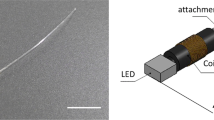Abstract
Background: In 1975 one of us (J.P.) first described endoscopic marking of the intestinal lumen with india ink to produce a serosal tattoo, thus facilitating the location of lesions during subsequent surgery. The use of the technique in concert with laparoscopic surgery is particularly important because the ability to palpate the bowel is lost. Carbon-based products such as india ink provide permanent marking. An alternative marker is methylene blue, whose mark is only temporary but clearly seen laparoscopically. Methods: We have used methylene blue for intraoperative marking, reserving India ink for instances in which marking endoscopy occurs before surgery. Results: 15 patients, over a period of 2 years, had endoscopic marking performed preoperatively or intraoperatively. All markings were easily visualized upon laproscopy, assisting identification of the sites of the lesions. Numerous other cases were marked at endoscopy but did not come to surgery. Conclusion: Endoscopic marking is an invaluable tool in the performance of laparoscopic gastrointestinal surgery.
Similar content being viewed by others
Author information
Authors and Affiliations
Rights and permissions
About this article
Cite this article
Beretvas, R., Ponsky, J. Endoscopic marking: an adjunct to laparoscopic gastrointestinal surgery. Surg Endosc 15, 1202–1203 (2001). https://doi.org/10.1007/s004640000304
Published:
Issue Date:
DOI: https://doi.org/10.1007/s004640000304




